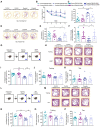Aberrant expression of FBXO22 is associated with propofol-induced synaptic plasticity and cognitive dysfunction in adult mice
- PMID: 36425318
- PMCID: PMC9680529
- DOI: 10.3389/fnagi.2022.1028148
Aberrant expression of FBXO22 is associated with propofol-induced synaptic plasticity and cognitive dysfunction in adult mice
Abstract
Recent observation demonstrated that prolonged anesthesia modifies brain synaptic architecture in all ages, including adult. Propofol is the most commonly utilized anesthetics at clinic. Whether repeated administration of propofol modulates cognitive impairment in adults and changes synaptic plasticity remains, however, to be explored. In this study, we first discovered that repeated and prolonged exposure to propofol-induced cognitive impairment in adult rodents. Then, we examined the property of hippocampal primary neurons and slices after propofol treatment in mice, including synaptic protein profile, dendritic spine density, as well as synaptic transmission. We found the distinctive change of the F-box only protein 22 (FBXO22), an F-box E3 ligase, during this process and further explored its role. Knockdown experiments showed the downregulation of FBXO22 restored the changes by propofol treatment on hippocampal primary neurons and attenuated propofol-induced hippocampal dependent cognitive dysfunction. Our results showed that FBXO22 is involved in the regulation of repeated propofol treatment induced changes of synaptic plasticity and cognitive dysfunction in adult mice. Repeated propofol treatment leads to cognitive dysfunction by regulating FBXO22 in adult rodents.
Keywords: FBXO22; general anesthesia; hippocampus; neurocognition; propofol.
Copyright © 2022 Yang, Chen, Qu, Liu, Wang, Wang, Fan, Zhou, Yu, Xue, Wu and Lu.
Conflict of interest statement
The authors declare that the research was conducted in the absence of any commercial or financial relationships that could be construed as a potential conflict of interest.
Figures







Similar articles
-
Hippocampal SIRT1-Mediated Synaptic Plasticity and Glutamatergic Neuronal Excitability Are Involved in Prolonged Cognitive Dysfunction of Neonatal Rats Exposed to Propofol.Mol Neurobiol. 2022 Mar;59(3):1938-1953. doi: 10.1007/s12035-021-02684-4. Epub 2022 Jan 16. Mol Neurobiol. 2022. PMID: 35034265
-
Repeated exposure to propofol in the neonatal period impairs hippocampal synaptic plasticity and the recognition function of rats in adulthood.Brain Res Bull. 2021 Apr;169:63-72. doi: 10.1016/j.brainresbull.2021.01.007. Epub 2021 Jan 13. Brain Res Bull. 2021. PMID: 33450329
-
Toll-Like Receptor 4 Deficiency Ameliorates Propofol-Induced Impairments of Cognitive Function and Synaptic Plasticity in Young Mice.Mol Neurobiol. 2024 Jan;61(1):519-532. doi: 10.1007/s12035-023-03606-2. Epub 2023 Aug 29. Mol Neurobiol. 2024. PMID: 37644280
-
FBXO22, an epigenetic multiplayer coordinating senescence, hormone signaling, and metastasis.Cancer Sci. 2020 Aug;111(8):2718-2725. doi: 10.1111/cas.14534. Epub 2020 Jul 17. Cancer Sci. 2020. PMID: 32536008 Free PMC article. Review.
-
Emerging role of FBXO22 in carcinogenesis.Cell Death Discov. 2020 Jul 27;6:66. doi: 10.1038/s41420-020-00303-0. eCollection 2020. Cell Death Discov. 2020. PMID: 32793396 Free PMC article. Review.
References
LinkOut - more resources
Full Text Sources

